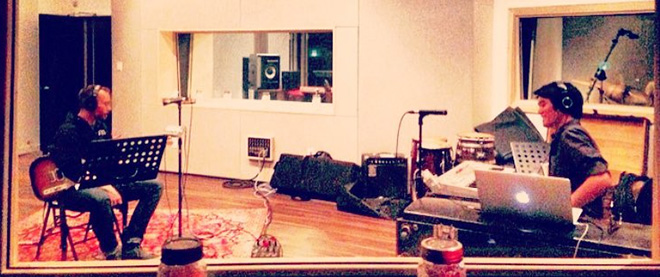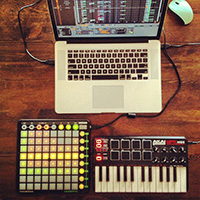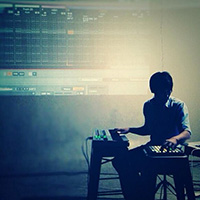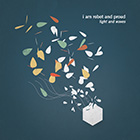I Am Robot And Proud - Interview & Album Release
Hello, tell us about yourself and what you do.
My name is Shaw-Han Liem, and I make music under the name, “I Am Robot and Proud” in Toronto, Canada. I've been doing this a while, since 2001. I also work in other mediums like programming visual projections and designing video games.
Could you talk a bit about your latest release, Light and Waves. Was there anything in particular that you wanted to achieve with it?
Immediately before this record I worked on one called “People Music”. The goal there was to create arrangements of my previous work for a live band (drums, bass, synth, guitar) that we could perform live as a group. In the process of doing so, I had to sort of explode my normal process of making songs (which previously revolved around Renoise). We recorded the album into Logic in the studio and I mixed it in a more traditional 'rock band' way. With “Light and Waves” I came back to my previous process, but I wanted to incorporate the new techniques that I used on “People Music” - doing a lot more live playing and improvisation. On the other hand, I also wanted to explore more 'computer assisted' techniques like using randomness in sample processing and the compositions. So I guess you could say “Light and Waves” is an attempt to have those two worlds living together - live musicians playing organically and using a computer as a compositional tool.
To what extent do you use Renoise in your creative process and what is the blend of hardware and software in your setup?
When I started out releasing albums in 2001, I did everything in trackers. I used FastTracker2 for my first two albums and Renoise after that. I don't think I had used a real hardware synth, VST instrument or effect until my fourth album, “Uphill City”. So Renoise really informed my process early on, like trying to stretch the most interesting sonic possibilities from a few pieces of sound. Since then, I've added a lot of things to my setup: hardware and software synths, drum machines, effects, etc. But much of my work still starts in a blank Renoise file.

You also perform your music live, but are live instruments involved much in your studio recordings?
Now I use a lot of live instruments during the recording process. Because Renoise has a built in sampler, I tend to improvise loops on guitar or synth, then chop them into sample instruments that I can use in tracks. On “Light and Waves” there are two tracks recorded with the full band, which are essentially recorded completely live in a traditional studio process.
And has Renoise been used on stage at all?
Yes! I've been using Renoise to run my live show since 2000. Early on I used it to basically control the playback of the track, but now I'm using it controlled by a Novation Launchpad and some custom scripts that I used to control Instrument switching and live looping (recording into the pattern editor in real time to create tracks on the fly).
For my live visuals, the setup is fairly simple. I have Renoise sending midi data for each track to Processing (audio-visual software), and also a custom LUA script that sends some extra info over OSC (Open Sound Control) - things like BPM, current position in the song, etc. From there I make a new sketch in Processing for each song and interpret the data coming in as visuals. For example, I map audio characteristics like note pitch, velocity and instrument visual things like shape, color, movement. I can have global changes happen as the song progresses, eg. when we get to the chorus, reverse gravity, change color scheme and speed up the camera movement. It's something I've been experimenting with for my last few tours, but I think only recently have I become comfortable with the process and starting to make some interesting work. I'm currently working on the next iteration of my visuals for my Japan tour in October.
Your music is available to buy on your bandcamp web-store, but it also receives physical releases through various labels. Could you give us an insight into how this approach to selling music works for you?
It basically comes down to having the music available in as many ways as possible and giving people the option of buying it where they are most comfortable. Some people prefer to buy on bandcamp, because they know the money goes directly to the artist. Other people prefer iTunes or their local record shop. Some people prefer streaming on youtube or streaming services (for an artist like me, this provides almost no income), and others just download it for free. It's really a complicated thing and no-one has really figured out a stable model. But I think having your music available in as many ways as possible gives you the best chance of connecting with the people who want to support you.

From this experience, do you have any advice for other musicians looking to have their music released?
It's a weird time to be doing music. There really is no template or 'business model' now and there is definitely less money going around, but there are still more crazy musical ideas to be discovered. I prefer to focus on that aspect of it, creating something new is a feeling that you can't really get anywhere else in life.
Who would you say have been your biggest musical influences and why?
I grew up in around a lot of other musicians - other teenagers that played in my local music scene (in and around Toronto). I would say that aspect of a local music community is the thing that influenced me the most. These days, with everything being online, the 'community' can span a larger geographical space, but I think the motivations and spirit is the same. And there is no substitute for standing in a room with your friends and having your mind blown by a cool band making weird music you've never heard before.
Are there any other things that you would say have an influence on your music?
I'm also influenced a lot by people in other fields - most recently, local game-maker friends who have to be both engineers and artists to create their work. I have become very interested in creating new tools for making my own music. I'm really inspired by the idea of an 'engineer/artist', who can use technology to create new tools and then use those tools to create new kinds of work - whether that be musical, visual or interactive.

How did you find out about Renoise and what attracted you to it in the first place?
I first started making music on a computer in high-school in the 90s - I think the first program I used was ModEdit on DOS. The reason was - it was free. You could literally make music even if you only had a PC and nothing else. From there I moved to FastTracker2 on Windows and I used that for a few albums. At some point I was playing a show and another artist on the bill saw I was using FastTracker2. He was like, "if you like that, you should check out Renoise!" From there I was basically hooked, all the comfortable micro-editing capabilities of a tracker, but with modern things like VST support and a scripting interface.
Is there anything about the software in particular that really helps you creatively?
As a musician and also a programmer and designer, I think the scripting interface (Renoise Tools) is one thing that really melted my brain the first time I tried it. It really opened up a lot of possibilities. I have made my own custom controllers on iPad that talk to Renoise over OSC and written scripts that manipulate note data (for example, 'find all kick drums and randomly shift them forward by half a step' or 'take all the notes in the track and shift them up or down by a minor third'). I find manipulating the compositions using code/algorithms has created a super fun way to find musical ideas that I would never consider when playing an instrument in the traditional way.
The iPad controller sounds intriguing, could you tell us more about it?
I guess it's a way for me to solve that problem of having a 'zoomed out' view of my songs as I'm working on them. It's a transport control and arrangement view where I can use touch gestures to zoom in and out of certain sections - or zoom all the way out to see all the tracks and patterns on one screen. From there it's easy to audition sections and arrangement ideas. It also works over wi-fi and has an instrument view/selector - so I can carry it around my studio and record overdubs into my Renoise session without having to look at the computer screen. I made it as an experiment using a game engine called cocos2d (since I have a background in game programming, it was the easiest way for me to get started). I have a custom Renoise tool written in LUA that communicates with the iPad app over OSC to send and receive all the information (so that anything you change on your computer is instantly reflected in the app and vice versa).
I worked on it on and off for a few months, creating a version that I could use while making “Light and Waves” - but then I got too busy recording the album, preparing the live band for tour etc. and haven't been able to go back to it since. I would love to return to it and eventually release it for the Renoise community, but I'm not sure when I'll have time to do so!
Are there any new features you'd like to see in a future version of Renoise?
I think Renoise (and trackers in general) are really good at showing you the 'zoomed in/micro' view of your music. In a way that no other kind of DAW really does, you are looking at your composition at a scale that allows you make tiny and subtle variations to notes and sequences pretty quickly and easily. I think where a tracker is lacking is in the 'macro/zoomed-out' view - where you have to look at the song as a whole and sculpt the arrangement at a larger granularity (maybe at the level of 'verse', 'chorus' etc). Is that really vague? To be honest I don't have an answer or feature suggestion to solve this, it's just something that I struggle with in the tracker world.
You've also been involved in other artistic mediums, such as games and midi-responsive visuals. Is this something you plan to continue doing?
I'm continuing to work in other fields like games, interactive art, visuals and procedural music. I basically see all of these things as related: using technology to create fun/interesting/important experiences.
And finally, do you have any upcoming shows or future releases planned that you can tell us about?
Once the album is out, I will be on tour all around Japan in October.
Light And Waves is available now in both digital and physical formats.
I Am Robot And Proud - Official Website
- Achenar's blog
- Log in to post comments











Recent comments